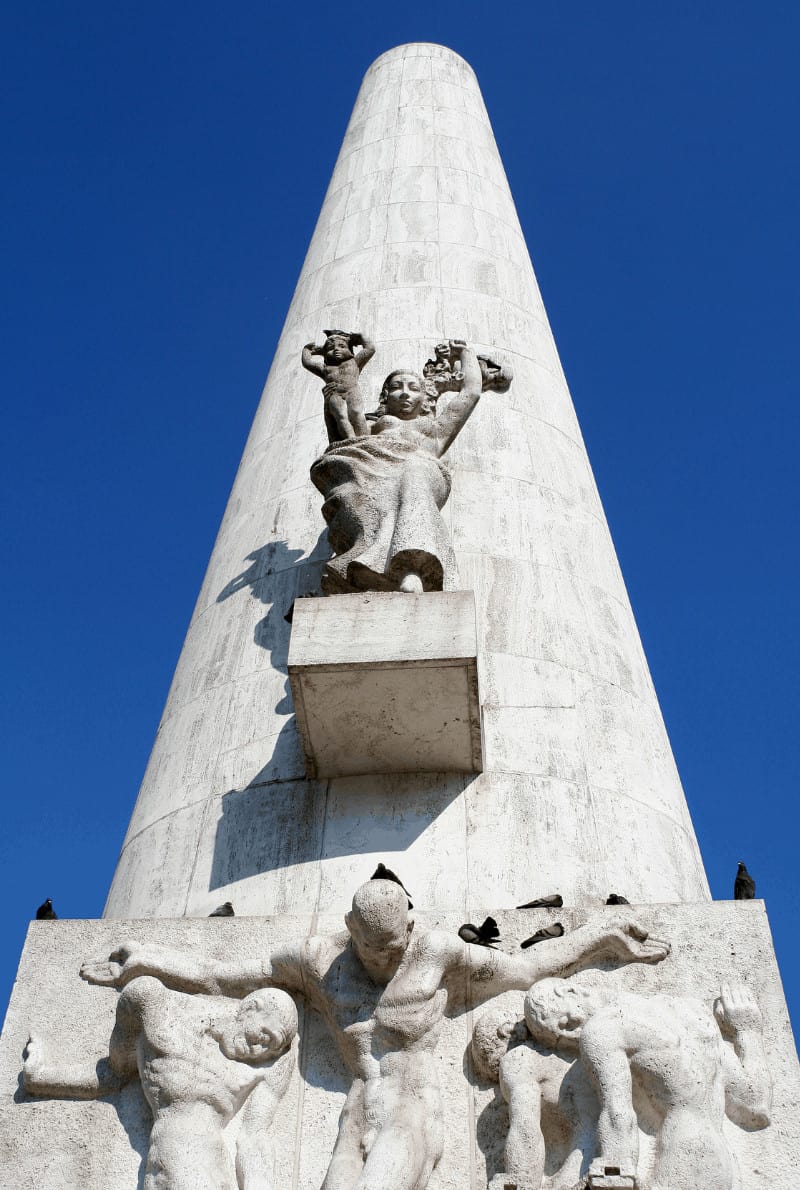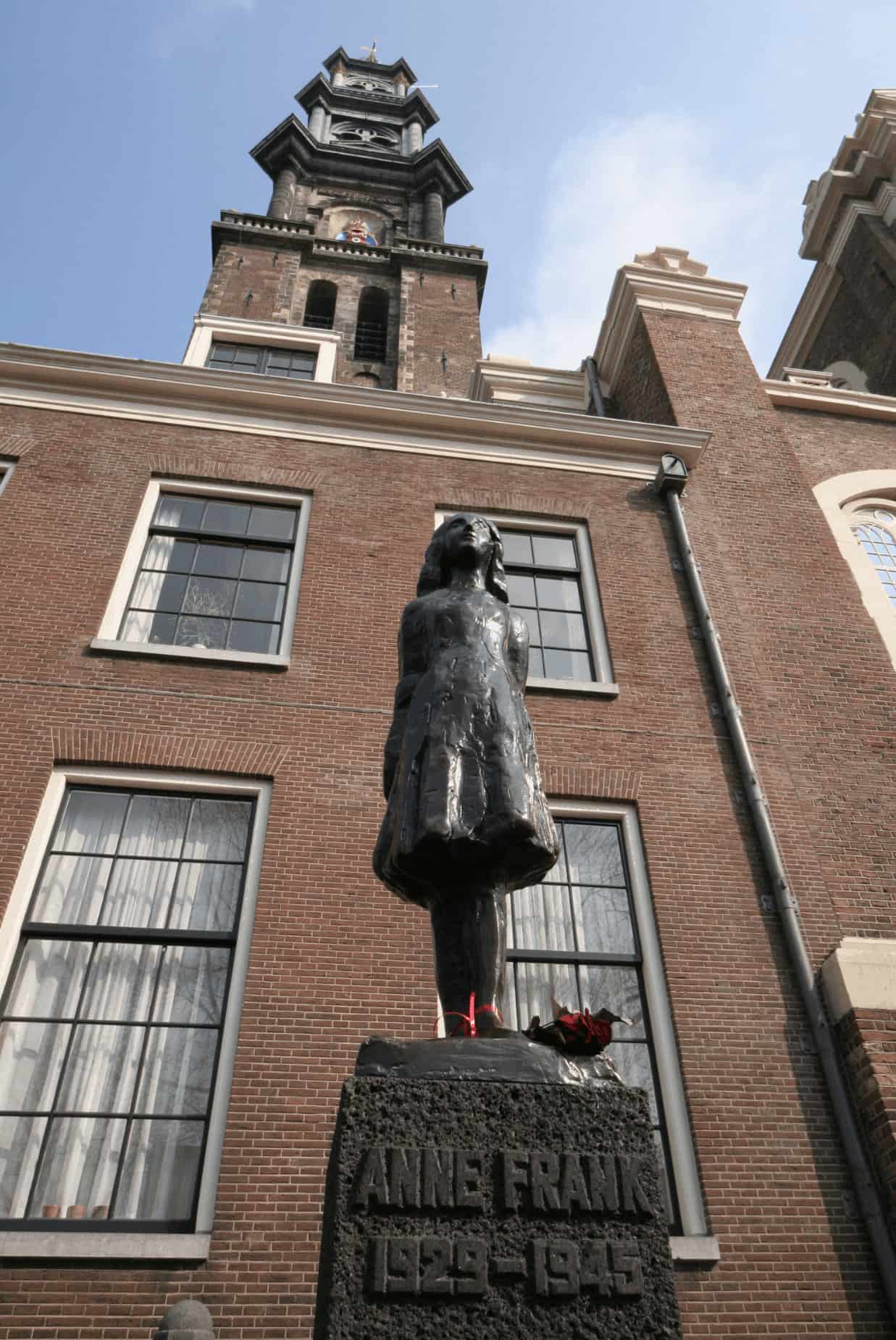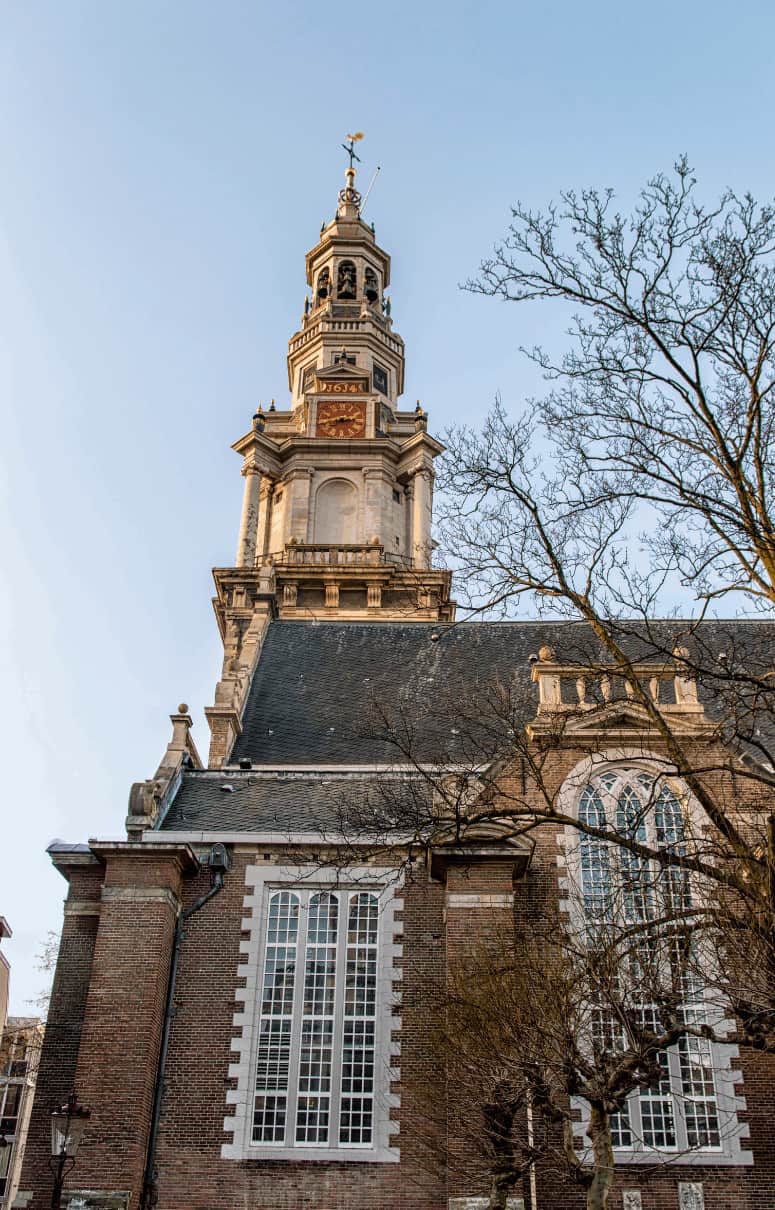Our walking tour will take you back in time, to Nazi occupied Amsterdam during the Second World War. Not only will we visit famous landmarks such as the Anne Frank House and the National Monument on Dam Square, but we’ll also hear the lesser-known stories of Jewish life and Dutch resistance behind some beautiful Amsterdam buildings and monuments. Did you know, for example, that a female Dutch artist hid a German poet and his Jewish students in her canal house Castrum Peregrini during the war, which led to a lifelong friendship and creative collaborations? Expect to hear many more special stories like this while taking in Amsterdam’s iconic buildings and streets around the old Jewish quarter and the canal belt.
Tour Creator
Jen is a writer from Amsterdam, where she spent her formative years in the vibrant Jewish Quarter. She holds a Bachelor’s of Liberal Arts in Art History, Literature and Performing…Read More Bio »
Amsterdam
GPS-directed
Remote Tour Included
1.5hrs/3hrs(Extended itinerary)
1.5km/3km(Extended itinerary)
Avoid the Crowds
Allows you to explore without having to be shoulder-to-shoulder in a large tour group
Expert-created Tour
Written by an Amsterdam-based writer with a Master of Arts in International Performance Research
GPS Directions
Easy-to-follow GPS directions to get you from one point to the next on your tour
Highlights include:
Zuiderkerk, the Portuguese Synagogue, the Auschwitz Monument, the Ann Frank House
Remote Tour Included
As with all our tours, a remote tour is included that can be enjoyed from home
Itineraries
Historical Amsterdam: Extended
Historical Amsterdam: Pt 1
Historical Amsterdam: Pt 2
- De Waag -Located in the very centre of the Nieuwmarkt, this was built in 1488 as Amsterdam’s city gate. Later, it functioned as the place where trading goods were weighed. In 1932, The Jewish Historical Museum opened in De Waag, but when the Nazis invaded in 1940 the museum was shut down.
- The Zuiderkerk - Located in the serene Zuiderkerkhof (‘Southern Graveyard’), this church, built in 1611, served as a morgue during the hunger winter in the Second World War.
- Statue of Baruch Spinoza - Baruch Spinoza is one of the most influential Dutch philosophers. He stood for tolerance, freedom of religion and freedom of expression. Spinoza was of Portuguese-Jewish descent and was banished from Amsterdam following accusations of heresy by the Jewish community’s rabbis.
- The Portuguese Synagogue - One of the most important landmarks of Jewish Amsterdam. Built in the 17th century for the large Portuguese-Jewish community that had fled to Amsterdam, the synagogue was shut down during the war but miraculously survived with everything still intact.
- De Dokwerker - A statue commemorating the large labourer’s strike that was organised spontaneously in February 1941, as a protest against the Nazi occupation. Every 25th of February, a memorial service is held here.
- The Joods Historisch Museum - The Jewish Historical Museum opened in De Waag in 1932, was closed by the Nazis in 1940, and reopened in 1955. At that point, the majority of the collection had disappeared. In 1987, the museum relocated to the High German Synagogue complex on the Jonas Daniël Meijerplein, where it remains to this day with an incredible collection and high-quality permanent and temporary exhibitions.
- Auschwitz Monument - This monument was designed by Dutch author Jan Wolkers. It consists of broken shards of glass which reflect a shattered sky, symbolising the forever destructed heavens in a world that has seen the horrors of Auschwitz. A sign on the monument reads Nooit Meer Auschwitz (‘Never Again Auschwitz’).
- Hollandsche Schouwburg and National Holocaust Museum - The Hollandsche Schouwburg used to be a theatre, but became used as a deportation centre for Jews in Amsterdam during the Second World War. Across the street is the National Holocaust Museum, located in the former Kweekschool. During the war, thousands of Jewish children were smuggled from the next-door Jewish kindergarten to the Kweekschool, and from there to safety.
- Artis Zoo - This zoo is is an Amsterdam gem, but few people know that it played a special role during the Second World War. Artis remained open during the war, and several Jews went into hiding in the zoo itself, surviving the war thanks to the care and loyalty of the zoo employees.
- Schuilsynagoge - Since the Portuguese Synagogue shut down during the war, Jewish couple Salomon Mendes and Elisabeth Coutinho-Sarphati started a secret synagogue in their own apartment. They would host services on Saturdays and holidays, and even created a mikwe (ritual bath) in the basement.
- Schaduwkade - People living on the Nieuwe Keizersgracht started an initiative to commemorate the former Jewish inhabitants of their houses, who did not survive the war. All along the canal, you can see plaques bearing the names and house numbers of the former inhabitants of this street.
- Student Association Unica - Most of the students of Student Association Unica 1943 refused to declare their loyalty to the German regime, which was mandatory for university students at the time. Many of them subsequently went into hiding outside of Amsterdam. Others remained in the house and were active members of the Resistance, saving several Jewish lives.
- Castrum Peregrini - In 1941, Dutch artist Gisèle van Waterschoot van der Gracht moved into this building on the Herengracht. She soon took in a German poet and his Jewish students, who were looking for a hiding place. Together, they started a flourishing artistic community which lasted on long after the war.
- Westerkerk - The Westerkerk was built in the Dutch Renaissance style as a protestant church. Arguably the most picturesque part of the Westerkerk is its clock tower, which, with a height of 85 metres, is the tallest church tower in Amsterdam.
- Anne Frank House - The Anne Frank House is one of the most important Amsterdam landmarks. This is where Anne Frank and her family went into hiding in the Achterhuis (‘back house’) of Otto Frank’s office.
- The National Monument - This monument on Dam Square is dedicated to all those who fell in the Second World War. Every May 4th, the square fills up for the National Remembrance of the Holocaust, with trumpets playing the Death March and two minutes of silence at 8 pm.
- De Waag -Located in the very centre of the Nieuwmarkt, this was built in 1488 as Amsterdam’s city gate. Later, it functioned as the place where trading goods were weighed. In 1932, The Jewish Historical Museum opened in De Waag, but when the Nazis invaded in 1940 the museum was shut down.
- The Zuiderkerk - Located in the serene Zuiderkerkhof (‘Southern Graveyard’), this church, built in 1611, served as a morgue during the hunger winter in the Second World War.
- Statue of Baruch Spinoza - Baruch Spinoza is one of the most influential Dutch philosophers. He stood for tolerance, freedom of religion and freedom of expression. Spinoza was of Portuguese-Jewish descent and was banished from Amsterdam following accusations of heresy by the Jewish community’s rabbis.
- The Portuguese Synagogue - One of the most important landmarks of Jewish Amsterdam. Built in the 17th century for the large Portuguese-Jewish community that had fled to Amsterdam, the synagogue was shut down during the war but miraculously survived with everything still intact.
- De Dokwerker - A statue commemorating the large labourer’s strike that was organised spontaneously in February 1941, as a protest against the Nazi occupation. Every 25th of February, a memorial service is held here.
- The Joods Historisch Museum - The Jewish Historical Museum opened in De Waag in 1932, was closed by the Nazis in 1940, and reopened in 1955. At that point, the majority of the collection had disappeared. In 1987, the museum relocated to the High German Synagogue complex on the Jonas Daniël Meijerplein, where it remains to this day with an incredible collection and high-quality permanent and temporary exhibitions.
- Auschwitz Monument - This monument was designed by Dutch author Jan Wolkers. It consists of broken shards of glass which reflect a shattered sky, symbolising the forever destructed heavens in a world that has seen the horrors of Auschwitz. A sign on the monument reads Nooit Meer Auschwitz (‘Never Again Auschwitz’).
- Hollandsche Schouwburg and National Holocaust Museum - The Hollandsche Schouwburg used to be a theatre, but became used as a deportation centre for Jews in Amsterdam during the Second World War. Across the street is the National Holocaust Museum, located in the former Kweekschool. During the war, thousands of Jewish children were smuggled from the next-door Jewish kindergarten to the Kweekschool, and from there to safety.
- Artis Zoo - This zoo is is an Amsterdam gem, but few people know that it played a special role during the Second World War. Artis remained open during the war, and several Jews went into hiding in the zoo itself, surviving the war thanks to the care and loyalty of the zoo employees.
- Schuilsynagoge - Since the Portuguese Synagogue shut down during the war, Jewish couple Salomon Mendes and Elisabeth Coutinho-Sarphati started a secret synagogue in their own apartment. They would host services on Saturdays and holidays, and even created a mikwe (ritual bath) in the basement.
- Schaduwkade - People living on the Nieuwe Keizersgracht started an initiative to commemorate the former Jewish inhabitants of their houses, who did not survive the war. All along the canal, you can see plaques bearing the names and house numbers of the former inhabitants of this street.
- Student Association Unica - Most of the students of Student Association Unica 1943 refused to declare their loyalty to the German regime, which was mandatory for university students at the time. Many of them subsequently went into hiding outside of Amsterdam. Others remained in the house and were active members of the Resistance, saving several Jewish lives.
- Castrum Peregrini - In 1941, Dutch artist Gisèle van Waterschoot van der Gracht moved into this building on the Herengracht. She soon took in a German poet and his Jewish students, who were looking for a hiding place. Together, they started a flourishing artistic community which lasted on long after the war.
- Westerkerk - The Westerkerk was built in the Dutch Renaissance style as a protestant church. Arguably the most picturesque part of the Westerkerk is its clock tower, which, with a height of 85 metres, is the tallest church tower in Amsterdam.
- Anne Frank House - The Anne Frank House is one of the most important Amsterdam landmarks. This is where Anne Frank and her family went into hiding in the Achterhuis (‘back house’) of Otto Frank’s office.
- The National Monument - This monument on Dam Square is dedicated to all those who fell in the Second World War. Every May 4th, the square fills up for the National Remembrance of the Holocaust, with trumpets playing the Death March and two minutes of silence at 8 pm.
Check out a free sample of this tour!
Share this tour
Facebook
Twitter
Pinterest
Get the tour in our app today!
Related Tours
No related posts.







